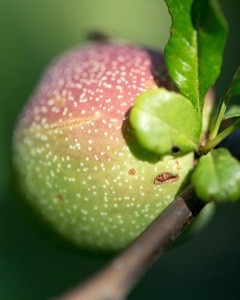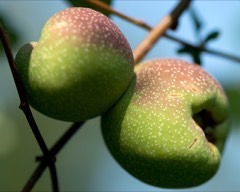 |
|
flickr.com/photos/138014579@N08/27826374264 |
 |
| flickr.com/photos/138014579@N08/27826374264 |
Translate this page:
Summary
Physical Characteristics

 Chaenomeles x californica is a deciduous Shrub growing to 1.8 m (6ft) by 1.8 m (6ft) at a medium rate.
Chaenomeles x californica is a deciduous Shrub growing to 1.8 m (6ft) by 1.8 m (6ft) at a medium rate.
See above for USDA hardiness. It is hardy to UK zone 5. The flowers are pollinated by Bees, Insects.
It is noted for attracting wildlife.
Suitable for: light (sandy), medium (loamy) and heavy (clay) soils and prefers well-drained soil. Suitable pH: mildly acid, neutral and basic (mildly alkaline) soils. It can grow in semi-shade (light woodland) or no shade. It prefers moist soil. It can tolerate atmospheric pollution.
UK Hardiness Map
US Hardiness Map
Synonyms
Chaenomeles x californica W.B.Clarke is an unresolved name. The hybrid C. x californica is a tri-species hybrid (C. x superba x C. cathayensis).
Plant Habitats
Edible Uses
Fruit - very harsh and acid raw but fragrant when cooked. Used for jams, jellies etc and as a flavouring with cooked apples[K]. The fruit can be apple or pear-shaped and up to 6cm long x 6cm wide[200]. The flesh is firm, fragrant and acidic.
References More on Edible Uses
Medicinal Uses
Plants For A Future can not take any responsibility for any adverse effects from the use of plants. Always seek advice from a professional before using a plant medicinally.
Possibly some medical uses. C. x californica is a tri-species hybrid (C. x superba x C. cathayensis). Chaenomeles cathayensis fruits is antiemetic, antirheumatic, antispasmodic and digestive[176]. It is used in the treatment of rheumatic pain, convulsions of the calf muscles, vomiting, dyspepsia and diarrhoea[176]. No medical uses are known for Chaenomeles x superba.
References More on Medicinal Uses
The Bookshop: Edible Plant Books
Our Latest books on Perennial Plants For Food Forests and Permaculture Gardens in paperback or digital formats.

Edible Tropical Plants
Food Forest Plants for Hotter Conditions: 250+ Plants For Tropical Food Forests & Permaculture Gardens.
More

Edible Temperate Plants
Plants for Your Food Forest: 500 Plants for Temperate Food Forests & Permaculture Gardens.
More

More Books
PFAF have eight books available in paperback and digital formats. Browse the shop for more information.
Shop Now
Other Uses
Plants can be grown to make a medium sized hedge[200]. Attractive flowers. Landscape Uses: Border, Erosion control, Ground cover, Massing, Woodland garden. Some cultivars of Chaenomeles x superba such as 'Crimson and Gold' produce suckers prolifically and are suitable for ground cover[182]. This may not by present in the hybrid.
Special Uses
References More on Other Uses
Cultivation details
The hybrid C. x californica is a tri-species hybrid (C. x superba x C. cathayensis). Named cultivars are available in the horticultural trade. Chaenomeles x californica is a strong growing quince with an upright crown reaching 1.8m high and wide. 'Enchantress' is a compact shrub single white to pink flowers and large yellow edible fruits. ?'Masterpiece' has large ovate fruit and pink-red flowers. Easily cultivated in any reasonably good soil[1, 200]. Prefers a deep moist well-drained loam[4, 11]. Grows well in heavy clay soils. Tolerates full shade but requires a sunny position for best fruit production[3, 11, 200]. Becomes chlorotic on very alkaline soils[188, 200]. Tolerates atmospheric pollution[200]. A very ornamental plant[1], it is hardy to about -25c[200]. Plants are subject to canker, especially when growing in the milder moister areas of Britain[49]. Plants in this genus are notably resistant to honey fungus[200]. Fruits are usually freely produced in Britain, but they do not always ripen[11, 182]. A good bee plant, flowering early in the year and providing pollen and nectar[108]. Landscape Uses: Border, Erosion control, Ground cover, Massing, Woodland garden. Special Features: Not North American native, Attractive flowers or blooms. In garden design, as well as the above-ground architecture of a plant, root structure considerations help in choosing plants that work together for their optimal soil requirements including nutrients and water. The root pattern is branching: a heart root, dividing from the crown into several primary roots going down and out [2-1].
References Carbon Farming Information and Carbon Sequestration Information
Temperature Converter
Type a value in the Celsius field to convert the value to Fahrenheit:
Fahrenheit:
The PFAF Bookshop
Plants For A Future have a number of books available in paperback and digital form. Book titles include Edible Plants, Edible Perennials, Edible Trees,Edible Shrubs, Woodland Gardening, and Temperate Food Forest Plants. Our new book is Food Forest Plants For Hotter Conditions (Tropical and Sub-Tropical).
Shop Now
Plant Propagation
Seed - best sown as soon as it is ripe in a sheltered position outdoors or in a cold frame[200]. Sow stored seed in February in a greenhouse[78]. Germination usually takes place within 6 weeks[78]. Prick out the seedlings into individual pots as soon as they are large enough to handle. If well grown, these seedling can be large enough to plant out in the summer, but give them some protection in their first winter. Otherwise plant them out in late spring of the following year[K]. This species is a hybrid and so will not breed true from seed. Cuttings of half-ripe wood, July/August in a frame[11]. Easy[113]. Cuttings of mature wood of the current year's growth, November in a cold frame. Layering in late spring or in autumn. This is a sure and easy method, though it takes 12 months[78, 200].
Other Names
If available other names are mentioned here
Californican Chaenomeles, californican quince, Flowering Quince
Native Range
Coming Soon
Weed Potential
Right plant wrong place. We are currently updating this section.
Please note that a plant may be invasive in one area but may not in your area so it's worth checking.
None Known
Conservation Status
IUCN Red List of Threatened Plants Status : Not Listed

Growth: S = slow M = medium F = fast. Soil: L = light (sandy) M = medium H = heavy (clay). pH: A = acid N = neutral B = basic (alkaline). Shade: F = full shade S = semi-shade N = no shade. Moisture: D = dry M = Moist We = wet Wa = water.
Now available:
Food Forest Plants for Mediterranean Conditions
350+ Perennial Plants For Mediterranean and Drier Food Forests and Permaculture Gardens.
[Paperback and eBook]
This is the third in Plants For A Future's series of plant guides for food forests tailored to
specific climate zones. Following volumes on temperate and tropical ecosystems, this book focuses
on species suited to Mediterranean conditions—regions with hot, dry summers and cool, wet winters,
often facing the added challenge of climate change.
Read More
Expert comment
Author
W.B.Clarke
Botanical References
Links / References
For a list of references used on this page please go here
Readers comment
| Add a comment |
|
If you have important information about this plant that may help other users please add a comment or link below. Only comments or links that are felt to be directly relevant to a plant will be included. If you think a comment/link or information contained on this page is inaccurate or misleading we would welcome your feedback at [email protected]. If you have questions about a plant please use the Forum on this website as we do not have the resources to answer questions ourselves.
* Please note: the comments by website users are not necessarily those held by PFAF and may give misleading or inaccurate information.
To leave a comment please Register or login here All comments need to be approved so will not appear immediately.
|
Subject : Chaenomeles x californica
|
|
|
|